UPDATED: JULY 13, 2023 | 1 MIN READ

According to the Association of American Medical Colleges, the United States faces a significant healthcare worker shortage of up to 124,000 physicians by 2034, including 48,000 in primary care. Additionally, the current situation highlights a shortage of registered nurses in hospitals, with factors such as burnout leading them to seek alternative roles.
The healthcare industry currently needs more healthcare workers, which significantly impacts patient care and access to healthcare services. The shortage is due to a combination of factors, including an aging workforce, a lack of interest in careers in healthcare, and a growing demand for healthcare services.
According to recent data, several states are experiencing a more significant shortage of healthcare workers than others. Some states facing the most significant healthcare worker shortage include California, Texas, Florida, and New York.
The shortage is particularly acute in rural areas, where there is a limited number of healthcare facilities and providers.
The current state of healthcare shortages in the US
Despite their dedicated efforts over the past three challenging years of caring for patients during the COVID-19 pandemic, nurses are leaving the healthcare industry in large numbers.
According to reports from various state health departments and hospital associations, this trend has led to widespread shortages nationwide. States are warning that this could result in an inability to provide adequate patient care in the event of a new outbreak.
One of the challenges encountered was the recurring pattern of insufficient staffing, leading to increased labor costs. The turnover rate also increased the expense of recruiting and training new staff.
Due to the attractive signing bonuses and higher hourly rates available from non-traditional employers, healthcare professionals, including nurses, are leaving the healthcare industry at an alarming rate.
As a result, hospitals are facing significant challenges in securing an adequate nursing workforce. To address this issue, hospital administrators are increasingly considering partnerships with nurse traveler agencies as a viable solution.
- The recurring pattern of insufficient staffing
- Labor wage challenges
- Aging patient population
- Aging nursing population
- Working environment conditions
- Low nursing school enrollment
- Worker burnout due to high-stress environments
- Government policies
What is being done to combat the healthcare worker shortage?
States are addressing the shortage of healthcare workers by implementing various strategies.
Strategies include increasing healthcare education and training programs, offering tuition reimbursement and loan forgiveness programs, and expanding telehealth services.
However, it will take time for these efforts to bear fruit, and in the meantime, patients may continue to face challenges in accessing the care they need.
Several solutions can be implemented to attempt to solve this shortage.
- Improve the working environment
- Increased pay
- Provide more schedule flexibility
- Provide context around policy changes
- Improved onboarding and training processes
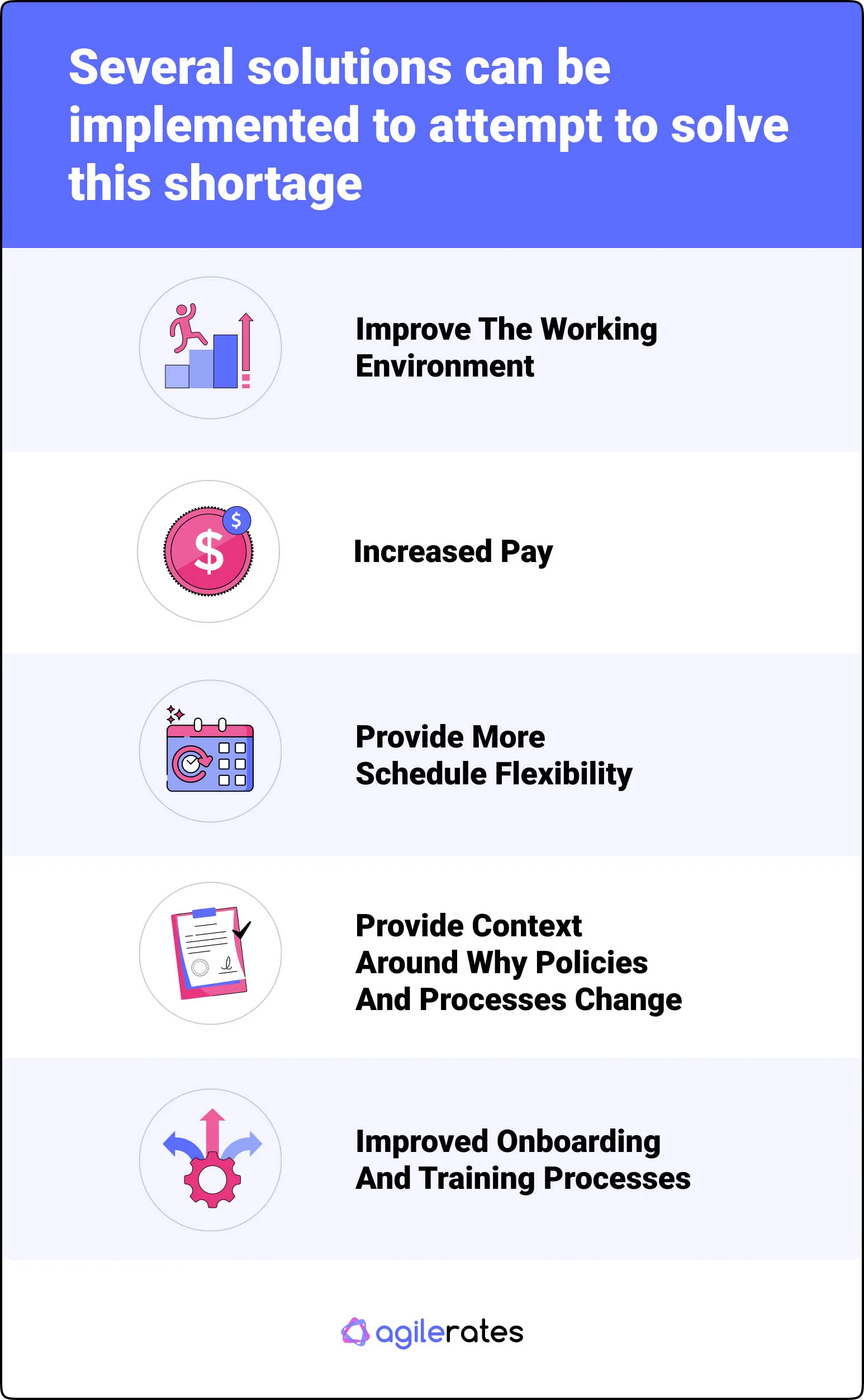
Which areas of healthcare are affected the most by the healthcare worker shortage?
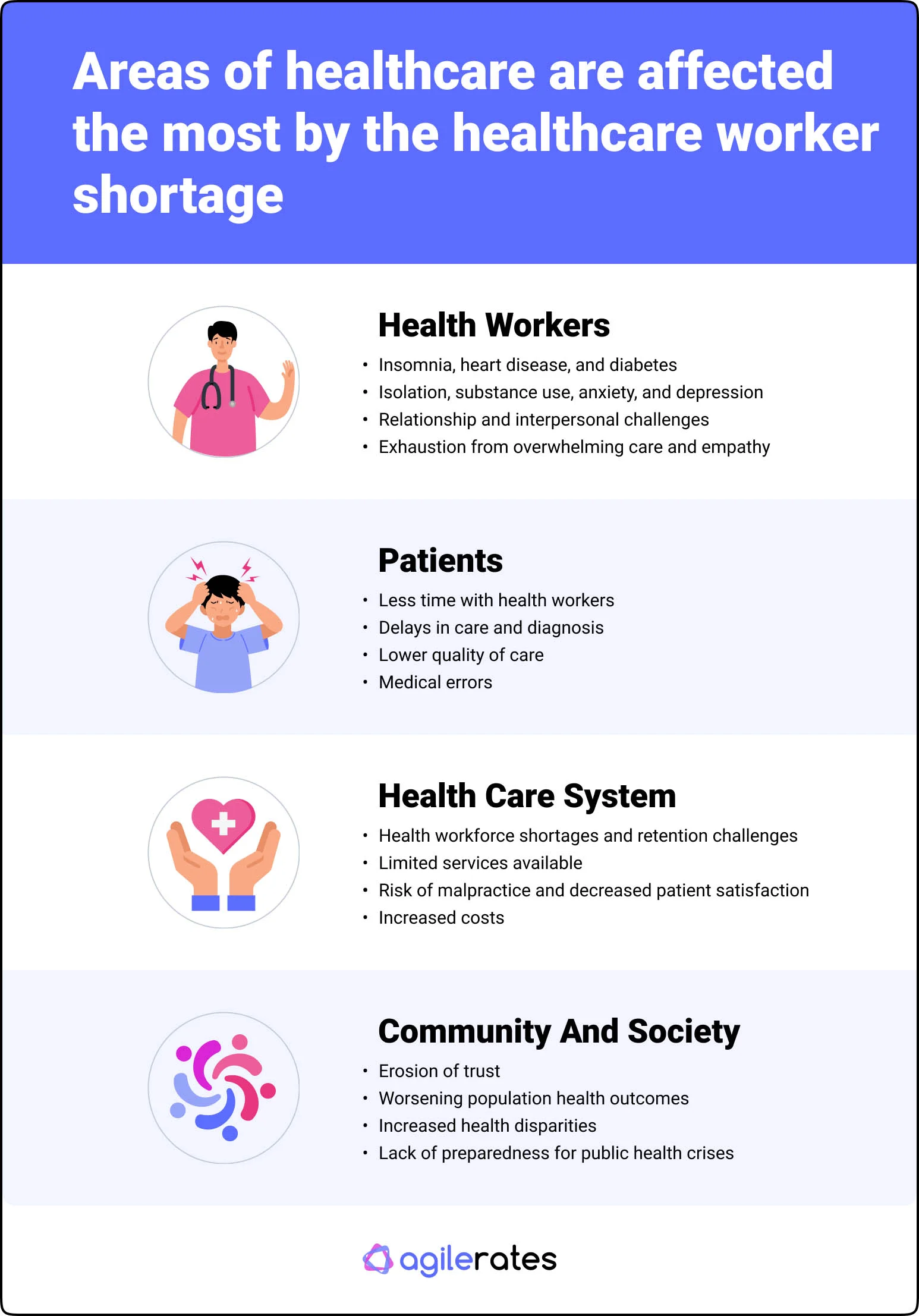
The healthcare industry is experiencing a significant increase in demand for skilled professionals.
Unfortunately, there is a noticeable shortage of qualified personnel in certain areas.
Although this workforce deficit is prevalent throughout the healthcare sector, some professions are more affected than others.
The lack of skilled professionals presents one of the most pressing challenges for the modern healthcare industry.
The three most notable areas for healthcare worker shortage are primary care, mental health, and dental workers.
States with the most significant primary care shortages
Recent statistical data reveal that Arizona, Hawaii, and Alaska are grappling with a significant scarcity of primary care providers, with over 80% of their respective counties reporting shortages.
Further, California, Maine, and Utah are among the top 10 states that confront acute primary care shortages, with 60%, 44%, and 41% of their counties facing the challenge. The average percentage of counties experiencing primary care shortages across states is 29%.
In sharp contrast, the states of Connecticut and New Jersey stand out as the sole ones where none of their counties have reported any shortage in primary care services.
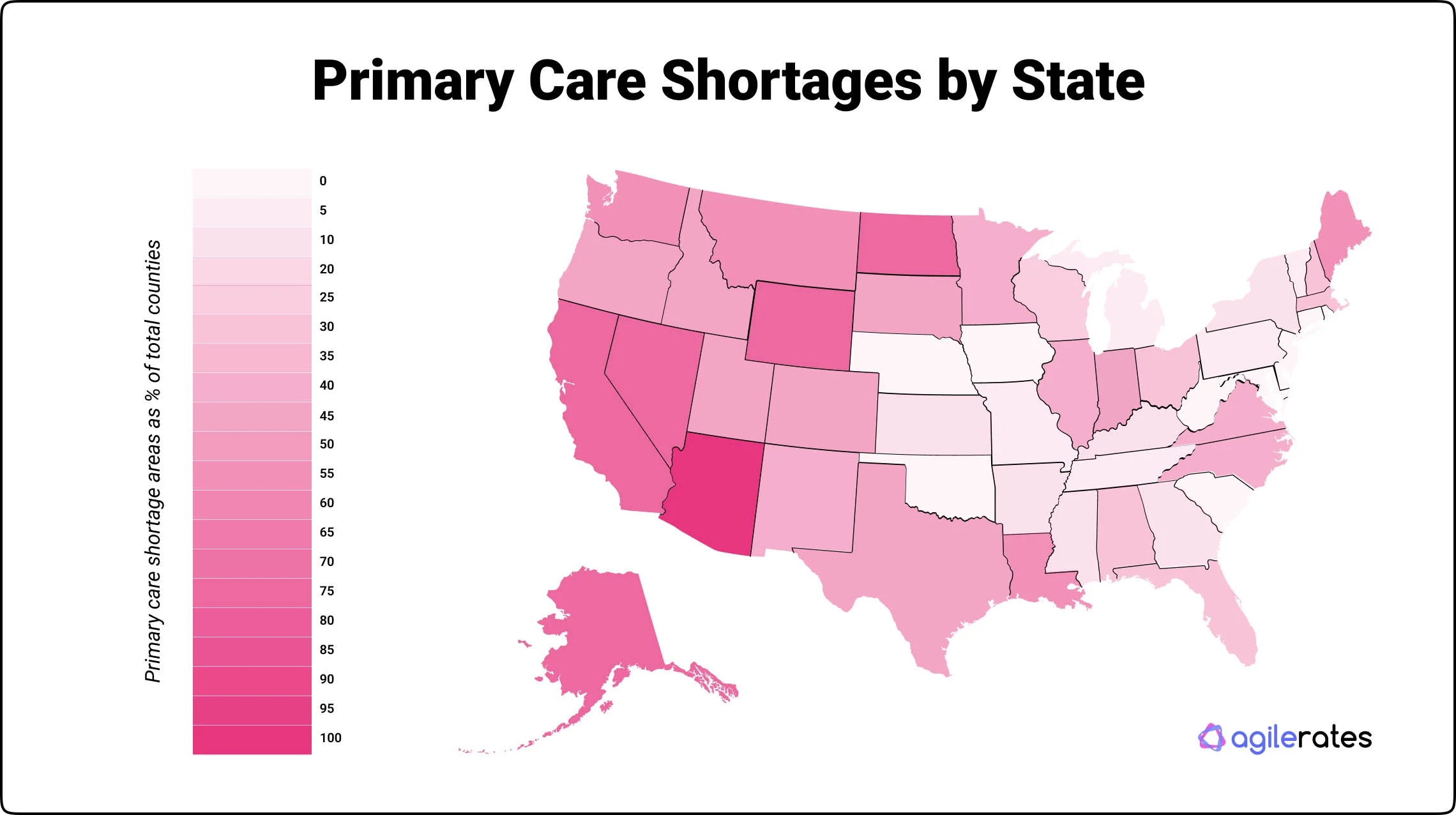
States with the most noteworthy mental health worker shortages
Based on recent analysis, it has been determined that several states in the United States, including Maine, Texas, Washington, Alaska, and Arizona, are struggling with shortages in mental health services.
Among the three health disciplines analyzed, Texas has the highest shortage percentage, with 58% of counties reporting a lack of mental health professionals.
This percentage is significantly higher than the national average of 16%. It is important to note that mental health professional shortages are ranked second among the three health disciplines evaluated.
For instance, even in Connecticut, where no counties are underserved in primary and dental health, 25% of counties are currently experiencing a shortage of mental health professionals.
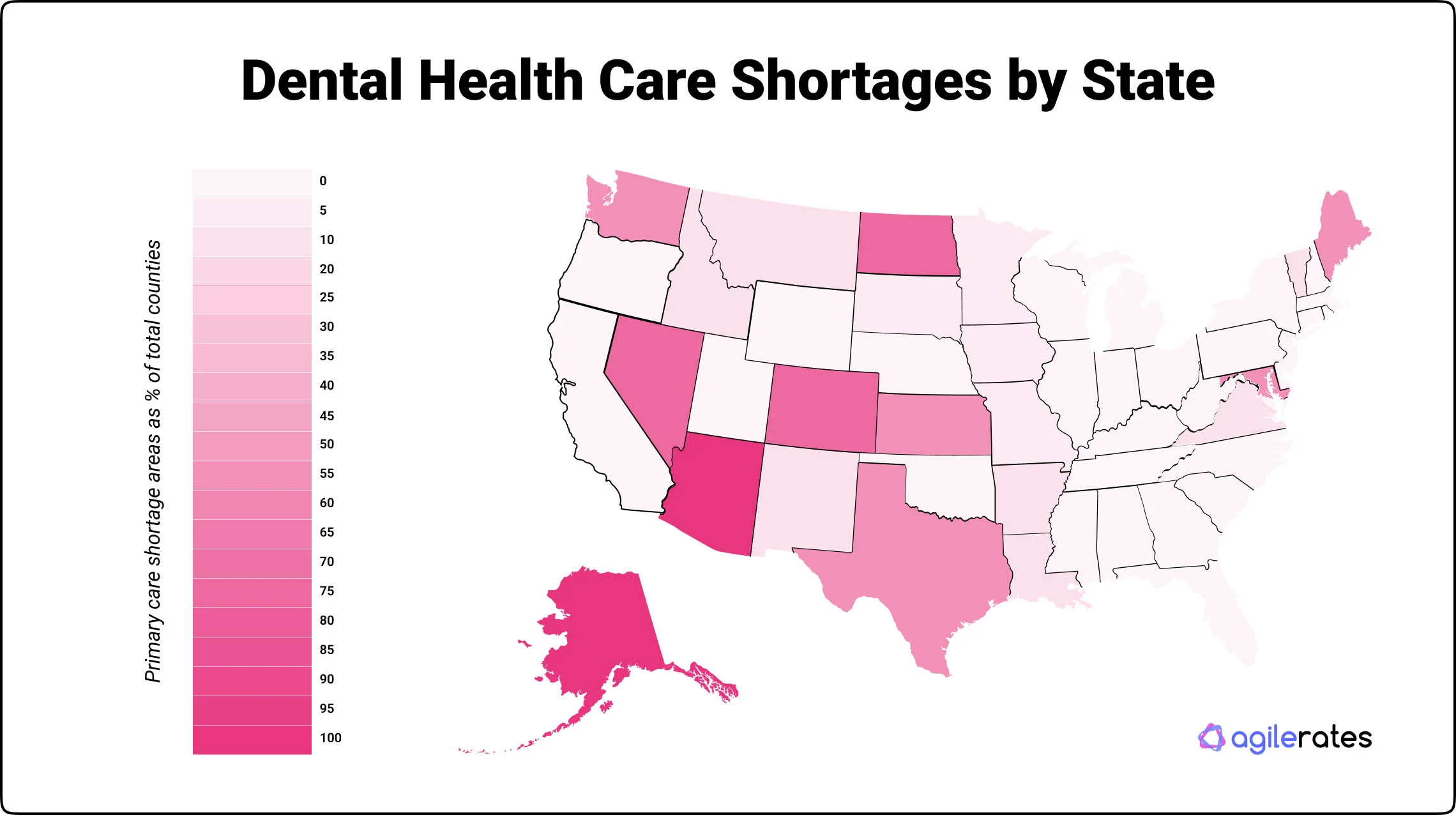
States with the most substantial dental health worker shortages
According to current data, Alaska and Arizona are the only states in the United States where more than 50% of their respective counties exhibit a shortage of dental health practitioners.
Meanwhile, Colorado faces a significant deficit in this field, with 31% of the state indicating a need for qualified experts.
Maryland is also experiencing a substantial fall in dental health professionals, with 25% of its counties reporting a need for qualified dental workers.
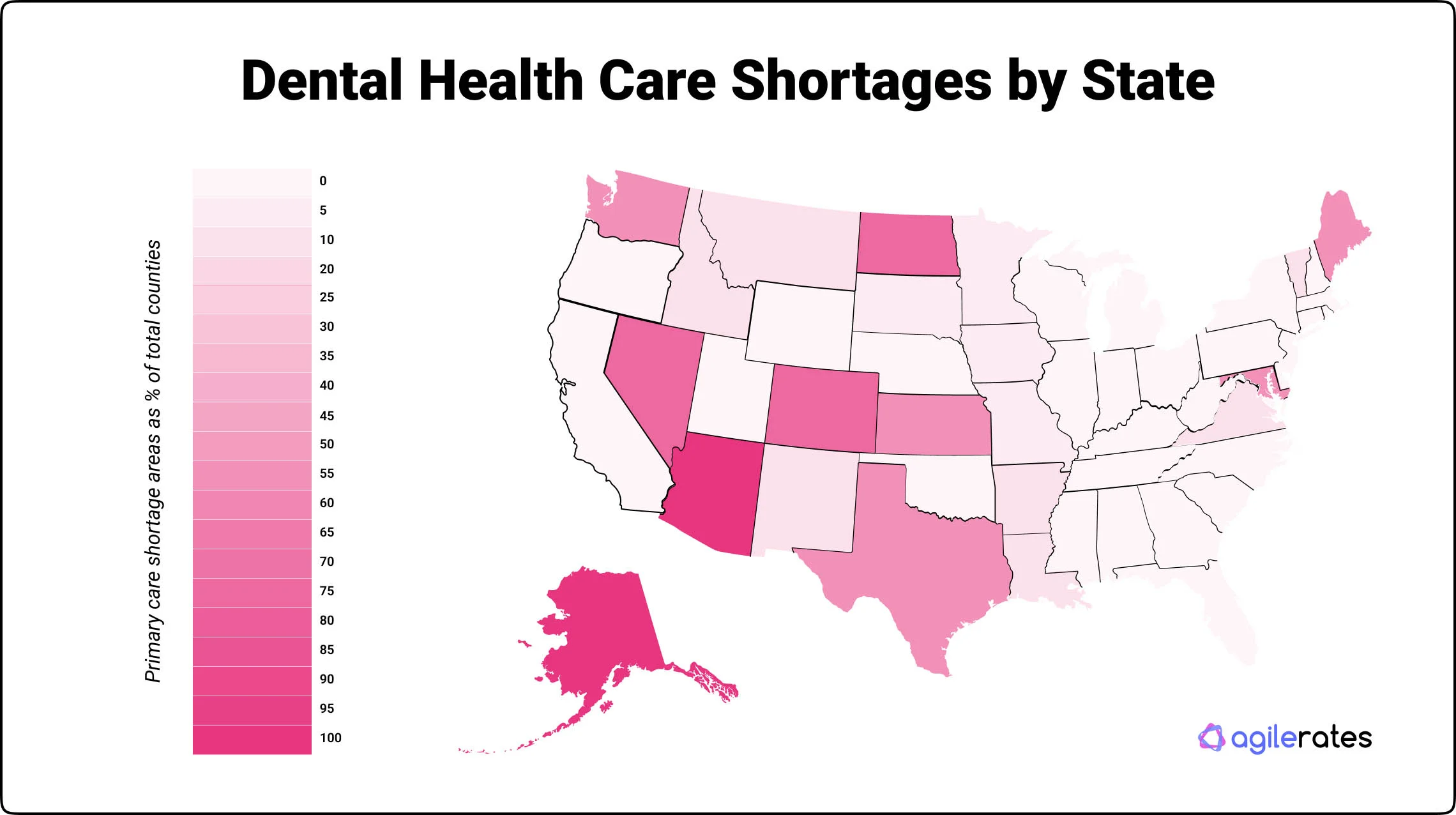
State rankings of healthcare providers
| Rank | State | Healthcare workers* | Primary care shortage | Mental health shortage | Dental health shortage |
|---|---|---|---|---|---|
| 1 | Nevada | 20.70 | 63% | 0% | 38% |
| 2 | California | 21.20 | 60% | 19% | 3% |
| 3 | Washington | 21.93 | 41% | 64% | 33% |
| 4 | Utah | 22.09 | 41% | 21% | 3% |
| 5 | Hawaii | 22.29 | 80% | 40% | 20% |
| 6 | New Mexico | 22.40 | 27% | 9% | 6% |
| 7 | Arizona | 22.52 | 100% | 100% | 67% |
| 8 | Idaho | 22.85 | 30% | 14% | 11% |
| 9 | Georgia | 23.56 | 9% | 4% | 4% |
| 10 | Texas | 23.66 | 34% | 58% | 20% |
| 11 | Alaska | 24.07 | 79% | 89% | 63% |
| 12 | Oregon | 24.53 | 25% | 3% | 0% |
| 13 | Oklahoma | 24.61 | 8% | 0% | 0% |
| 14 | South Carolina | 24.72 | 4% | 0% | 4% |
| 15 | Virginia | 24.77 | 25% | 5% | 7% |
| 16 | Florida | 24.99 | 19% | 16% | 3% |
| 17 | Wyoming | 25.43 | 78% | 0% | 4% |
| 18 | Colorado | 25.67 | 39% | 9% | 31% |
| 19 | New Jersey | 26.53 | 0% | 0% | 0% |
| 20 | Mississippi | 26.71 | 7% | 5% | 4% |
| 21 | Alabama | 26.80 | 18% | 3% | 0% |
| 22 | Arkansas | 26.84 | 11% | 3% | 8% |
| 23 | North Carolina | 26.86 | 13% | 15% | 2% |
| 24 | Iowa | 27.74 | 29% | 15% | 7% |
| 25 | Illinois | 27.80 | 31% | 26% | 4% |
| 26 | Kentucky | 27.81 | 17% | 7% | 1% |
| 27 | New York | 27.92 | 11% | 16% | 0% |
| 28 | Kansas | 28.06 | 17% | 18% | 23% |
| 29 | Louisiana | 28.30 | 36% | 38% | 8% |
| 30 | Michigan | 28.35 | 13% | 27% | 0% |
| 31 | Montana | 28.58 | 39% | 9% | 13% |
| 32 | Maryland | 28.66 | 21% | 21% | 25% |
| 33 | Connecticut | 28.75 | 0% | 25% | 0% |
| 34 | Tennessee | 28.86 | 8% | 5% | 1% |
| 35 | New Hampshire | 29.03 | 20% | 10% | 0% |
| 36 | Indiana | 29.16 | 33% | 11% | 0% |
| 37 | Wisconsin | 29.48 | 29% | 3% | 0% |
| 38 | Vermont | 30.62 | 14% | 0% | 14% |
| 39 | Maine | 30.84 | 44% | 56% | 19% |
| 40 | Ohio | 31.02 | 22% | 16% | 1% |
| 41 | Missouri | 31.27 | 6% | 0% | 9% |
| 42 | Rhode Island | 31.32 | 20% | 0% | 0% |
| 43 | Pennsylvania | 31.88 | 15% | 0% | 0% |
| 44 | Nebraska | 32.54 | 9% | 5% | 0% |
| 45 | West Virginia | 32.67 | 9% | 7% | 4% |
| 46 | Delaware | 32.76 | 33% | 0% | 0% |
| 47 | North Dakota | 33.96 | 77% | 6% | 38% |
| 48 | Minnesota | 33.99 | 34% | 7% | 7% |
| 49 | Massachusetts | 35.16 | 29% | 0% | 0% |
| 50 | South Dakota | 35.42 | 39% | 11% | 8% |
FAQs
Why is there a shortage of healthcare workers?
Burnout is a serious issue that can have far-reaching consequences for healthcare workers. One of its significant impacts is the potential for staffing shortages in healthcare facilities.
When healthcare professionals experience burnout, they may opt to leave the profession, resulting in a difficult challenge for healthcare organizations in finding replacement staff.
This can lead to several issues, including increased workload for remaining staff, reduced quality of care for patients, and financial strain on healthcare organizations as they attempt to recruit and retain new staff.
What areas of the United States have healthcare shortages?
According to recent data on Healthcare Professional Shortage Areas (HPSAs), states with predominantly rural populations, such as Utah, Vermont, and Tennessee, face significant shortages of healthcare professionals.
What’s the burnout rate for nurses?
Recent studies have revealed a noteworthy proportion of nurses experiencing burnout in the past three years, with an alarming 95% acknowledging its impact. This starkly contrasts the mere 15.6% of nurses who expressed burnout in 2019.
The advent of the COVID-19 pandemic has seen a sharp surge in this percentage, with 62% of nurses reporting experiencing burnout. Additional research indicated a concerning 30% resignation rate of nurses from their positions in the United States in 2021.
Which State has the highest healthcare worker shortage?
California is currently grappling with a severe dearth of qualified nursing staff, identified as the most pressing in the United States. Experts have projected that by 2030, California will face an acute shortage of more than 44,000 registered nurses.
This issue is not unique to California, as other states such as Vermont, New Mexico, Rhode Island, Arizona, and West Virginia are also experiencing significant staffing shortfalls within their healthcare facilities.
Why are new nurses leaving healthcare?
Nursing professionals indicate that their employment positions offer restricted scheduling flexibility, leading to limited personal time for social and family engagements. Additionally, they have expressed a lack of adequate opportunities for career advancement.
While it’s true that there is a shortage of healthcare workers in the US, that doesn’t mean you can’t find quality healthcare. Review the top plans in your area by filling out our online comparison form, or call, and we’ll connect you with a licensed healthcare professional.
Sources – AgileRates extracted and analyzed data from the following to provide data in this article.
- “These 13 States Are Facing The Worst Hospital Worker Shortages As Omicron Fuels A New Covid Surge” (Forbes)
- “Primary Care Health Professional Shortage Areas” (Kaiser Family Foundation)
Related articles
- How Does Travel Nursing Health Insurance Work
- Your Complete Guide on Short-Term Medical Plans
- States Where Health Insurance Costs the Most & Least
- Complete Guide on All Types Of Health Insurance Plans
- What is Telehealth Services, and is It the New Norm?